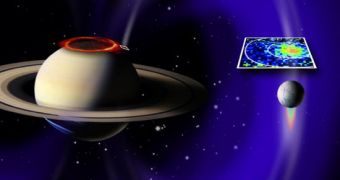Using the latest data collected by the NASA Cassini orbiter, astronomers were able to determine that the moon Enceladus plays an important role in the creation of auroras on its home planet, Saturn.
Investigators learned that the moon releases massive plumes of electrically-charged particles, and that these surges flow to the gas giant's north pole, where they cause the northern lights. The light shows develop as if it were solar radiation that impacted Saturn's magnetosphere.
Observations of the most recent auroras that developed on the planet revealed structures the size of Sweden. Therefore, it can be said that the influence Enceladus has is not negligible, but detectable.
Similarly, plumes of electrons and ions released by the moon Io are causing auroras on the gas giant Jupiter, astronomers say. Io stands out from the crowd of other moons in the solar system because it is volcanically active.
On the other hand, Enceladus is also displaying activity at its south pole. Through features known as tiger stripes – basically cracks in the thick layer of ice covering it – water vapors and organic molecules are released very often.
These eruption apparently fuel the gas giant's E Ring with new matter constantly, contributing to maintaining it in balance, Space reports. These activities may be linked with the effects that the two moons have on their respective host planets.
Cassini reveals that the electrons and ions Enceladus emits travel alongside magnetic field lines that end on Saturn's north pole. The particles must cover about 150,000 miles (240,000 kilometers) before reaching their destination.
In the latest observations, experts found a path of aurora events that spanned 750 miles (1,200 kilometers) by about 250 miles (400 kilometers), Analysis of their brightness revealed that the northern lights varied in intensity constantly.
This means that the rate at which Enceladus spews out charged particles is not constant, but rather varies on some yet-unknown factors.”The electron beams flicker with timescales on the order of minutes. It is a very dynamic interaction,” says Abigail Rymer.
The researcher holds an appointment as a Cassini team scientist, and is based at the Johns Hopkins University (JHU). She was also a coauthor of a study detailing the findings, which was published in the April 21 issue of the top journal Nature.
The new study demonstrates that “one thing is clear: Enceladus cannot vent at this rate forever. Scientists have been wondering whether the venting rate is variable, and these new data suggest that it is,” Rymer concludes.

 14 DAY TRIAL //
14 DAY TRIAL //